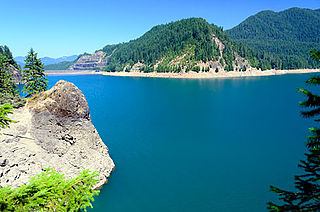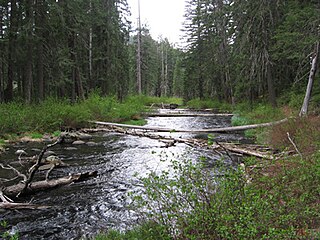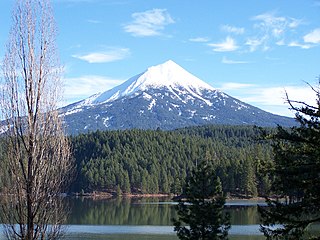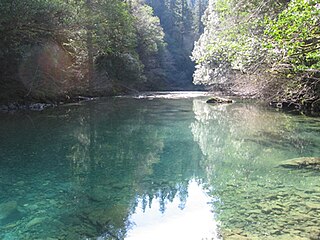| Salt Creek | |
Salt Creek in the canyon below Salt Creek Falls | |
| Name origin: Salt springs along the creek that attract deer [1] | |
| Country | United States |
|---|---|
| State | Oregon |
| County | Lane |
| Source | Lower Betty Lake |
| - location | southeast of Waldo Lake |
| - elevation | 5,481 ft (1,671 m) [2] |
| - coordinates | 43°40′09″N122°01′17″W / 43.66917°N 122.02139°W [3] |
| Mouth | Middle Fork Willamette River |
| - location | just below Hills Creek Dam |
| - elevation | 1,225 ft (373 m) [2] |
| - coordinates | 43°43′31″N122°26′16″W / 43.72528°N 122.43778°W Coordinates: 43°43′31″N122°26′16″W / 43.72528°N 122.43778°W [3] |
| Length | 30 mi (48 km) [4] |
Salt Creek is a tributary, 30 miles (48 km) long, of the Middle Fork Willamette River in Lane County in the U.S. state of Oregon. [1] [3] [4] It is named for salt springs along its banks that are used as licks by deer. [1] [5] The stream originates as an outflow of Lower Betty Lake in the forested Cascade Range just southeast of Waldo Lake. From its source, Salt Creek flows generally south, through Gold Lake, to Route 58, which it then follows mainly northwest for about 26 miles (42 km) to its mouth at the Middle Fork Willamette River just below Hills Creek Dam. [6] [7] [8] At Salt Creek Falls—roughly 4 miles (6.4 km) west of Willamette Pass and a little more than 22 miles (35 km) upstream from the mouth [7] [9] —the stream plunges 286 feet (87 m), [10] discharging an average of 50,000 U.S. gallons (190,000 L) of water per minute, or 111 cubic feet per second (3.1 m3/s). [11] Below the falls, the creek enters a narrow canyon shaped by glaciation and basalt lava flows from higher in the Cascades. [9] [12] McCredie Hot Springs, at the former community of McCredie Springs, are natural hot springs along the lower half of Salt Creek beside Route 58. [13] [14]

The Middle Fork Willamette River is one of several forks that unite to form the Willamette River in the western part of the U.S. state of Oregon. It is approximately 115 miles (185 km) long, draining an area of the Cascade Range southeast of Eugene, which is at the southern end of the Willamette Valley.

Lane County is a county in the U.S. state of Oregon. As of the 2010 census, the population was 351,715, making it the fourth-most populous county in Oregon. The county seat is Eugene. It is named in honor of Joseph Lane, Oregon's first territorial governor.

The United States of America (USA), commonly known as the United States or America, is a country composed of 50 states, a federal district, five major self-governing territories, and various possessions. At 3.8 million square miles, the United States is the world's third or fourth largest country by total area and is slightly smaller than the entire continent of Europe's 3.9 million square miles. With a population of over 327 million people, the U.S. is the third most populous country. The capital is Washington, D.C., and the largest city by population is New York City. Forty-eight states and the capital's federal district are contiguous in North America between Canada and Mexico. The State of Alaska is in the northwest corner of North America, bordered by Canada to the east and across the Bering Strait from Russia to the west. The State of Hawaii is an archipelago in the mid-Pacific Ocean. The U.S. territories are scattered about the Pacific Ocean and the Caribbean Sea, stretching across nine official time zones. The extremely diverse geography, climate, and wildlife of the United States make it one of the world's 18 megadiverse countries.
The Salt Creek watershed is a temperate coniferous forest in which the primary tree species include Douglas fir, western hemlock, and mountain hemlock. [15] [16] [17] Fish species in Salt Creek are primarily trout, [18] especially coastal cutthroat trout, rainbow trout, and non-native brook trout. [19] The brook trout were introduced into lakes in and around the Salt Creek watershed, and many now live in upper Salt Creek. Bull trout formerly inhabited Salt Creek until damage to habitat throughout the Willamette River basin, such as the construction of dams, reduced and eliminated some populations in the Willamette's watershed. [20]

Temperate coniferous forest is a terrestrial habitat type defined by the World Wide Fund for Nature. Temperate coniferous forests are found predominantly in areas with warm summers and cool winters, and vary in their kinds of plant life. In some, needleleaf trees dominate, while others are home primarily to broadleaf evergreen trees or a mix of both tree types. A separate habitat type, the tropical coniferous forests, occurs in more tropical climates.

Pseudotsuga menziesii is an evergreen conifer species in the pine family, Pinaceae. It is native to western North America and is known as Douglas fir, Douglas-fir, Oregon pine, and Columbian pine. There are two varieties: coast Douglas-fir, and Rocky Mountain Douglas-fir.

Tsuga heterophylla, the western hemlock or western hemlock-spruce, is a species of hemlock native to the west coast of North America, with its northwestern limit on the Kenai Peninsula, Alaska, and its southeastern limit in northern Sonoma County, California.
















